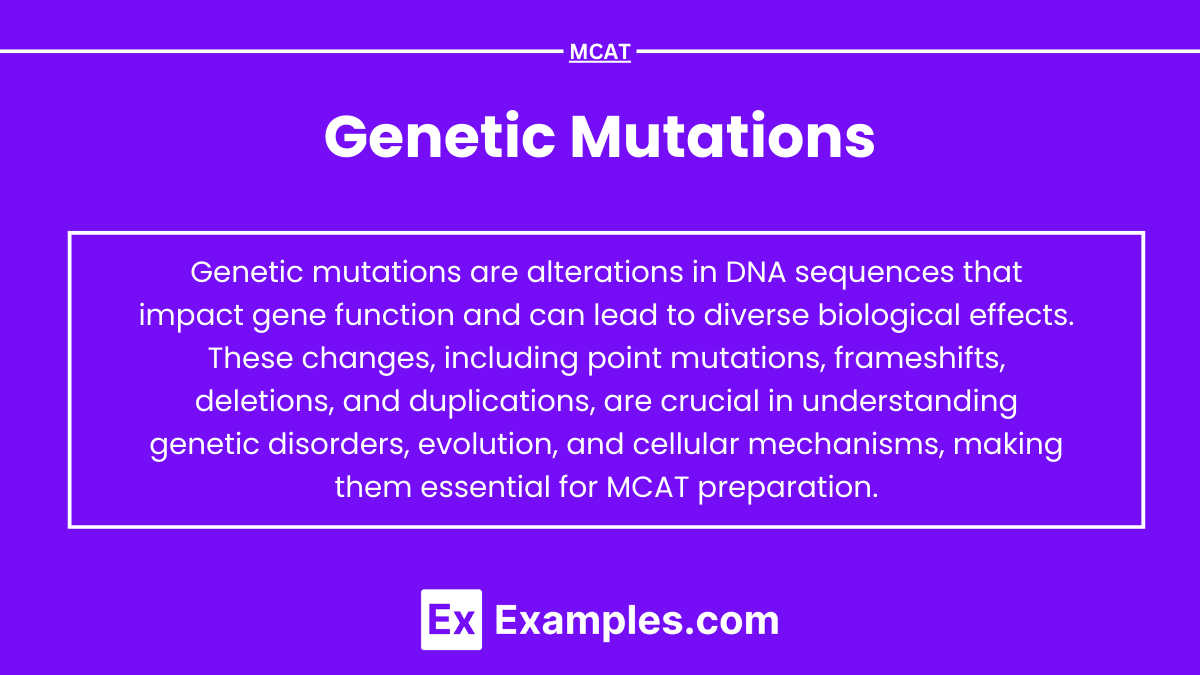Genetic Mutations

- Notes
Genetic mutations are changes in the DNA sequence that can affect protein function and lead to various outcomes, from genetic diversity to disease. These mutations include point mutations, frameshifts, and larger chromosomal alterations. Understanding their types, causes, and impacts on health and evolution is essential for mastering genetics concepts on the MCAT.
Learning Objectives
In studying “Genetic Mutations” for the MCAT, you should learn to understand the types of genetic mutations, including point mutations, insertions, deletions, and frameshifts, and their effects on DNA and protein synthesis. Analyze how mutations can lead to altered gene expression and function, contributing to genetic disorders and cancer. Evaluate the mechanisms of DNA repair and the role of mutagens. Additionally, explore how genetic mutations influence evolutionary processes and apply these concepts to MCAT practice passages, interpreting data and experiments related to mutation and inheritance.
1. Definition and Types of Mutations
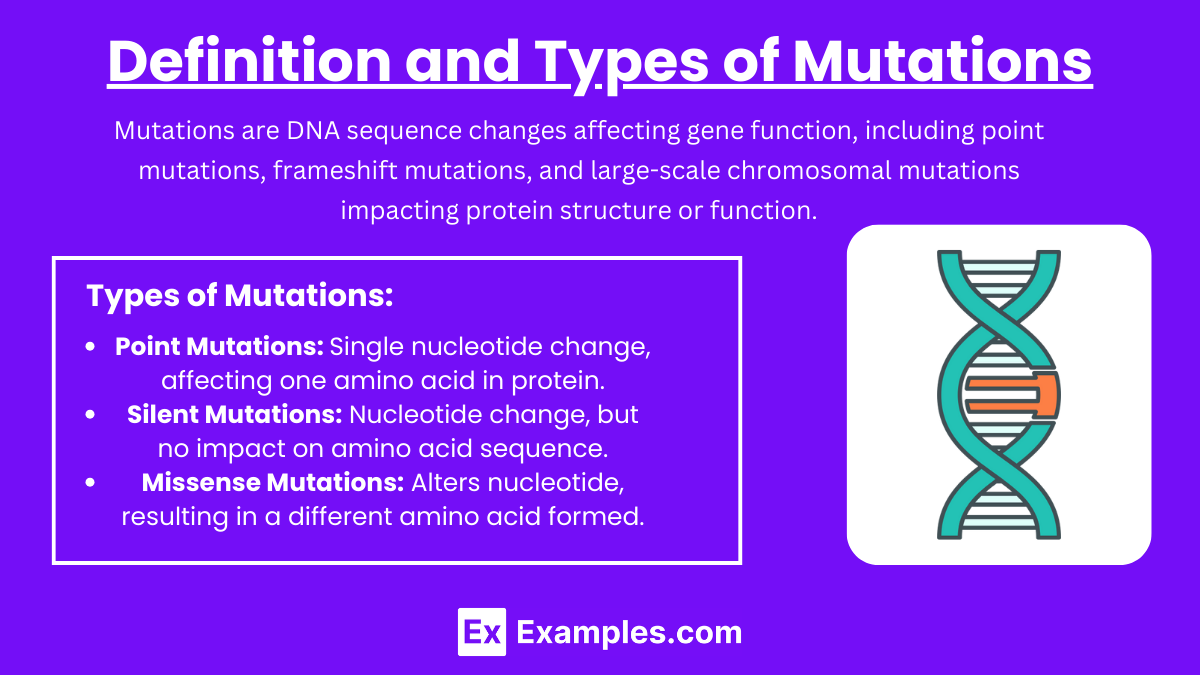
- Mutation: A change in DNA sequence, potentially impacting gene function.
- Types of Mutations:
- Point Mutations: Change in a single nucleotide; includes substitutions.
- Silent Mutations: No amino acid change due to codon redundancy.
- Missense Mutations: Alters an amino acid in the protein.
- Nonsense Mutations: Introduces a premature stop codon.
- Frameshift Mutations: Insertions or deletions that disrupt the reading frame, altering downstream amino acids.
- Large-Scale Mutations: Include duplications, deletions, inversions, and translocations impacting chromosomal structure.
- Point Mutations: Change in a single nucleotide; includes substitutions.
2. Causes of Genetic Mutations
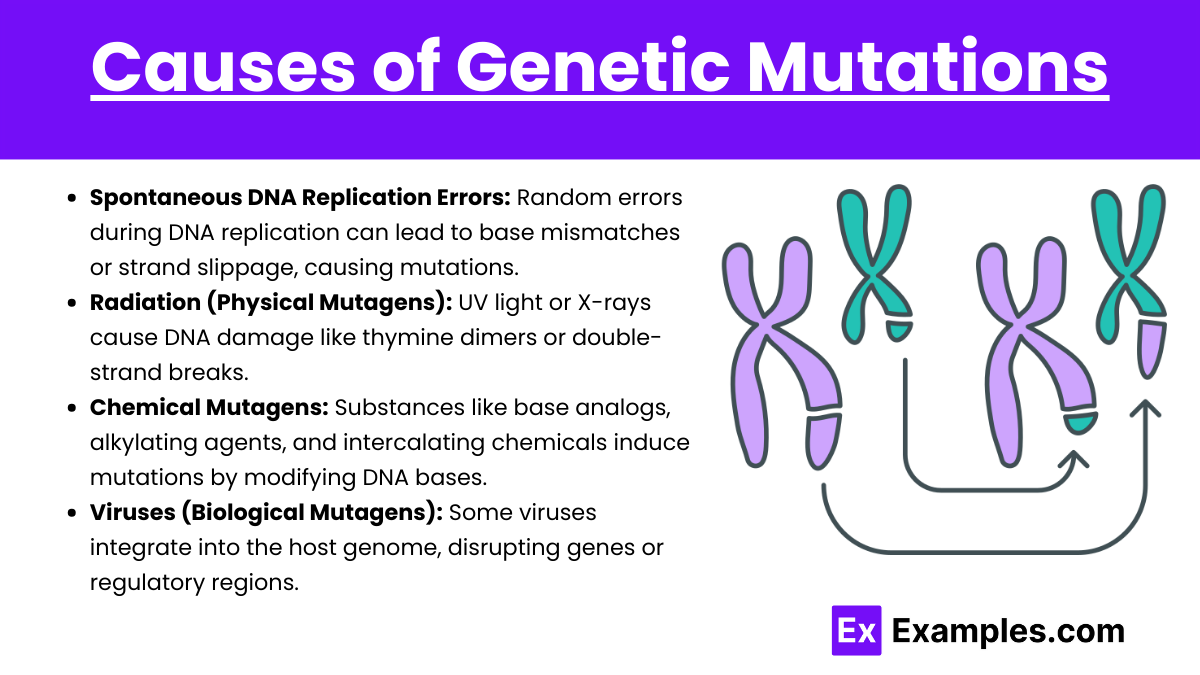
- Spontaneous Mutations: Occur naturally during DNA replication errors or spontaneous chemical changes.
- Induced Mutations: Caused by external factors (mutagens).
- Physical Mutagens: Radiation (UV light, X-rays) causing pyrimidine dimers or breaks.
- Chemical Mutagens: Base analogs, alkylating agents, and intercalating agents causing replication errors.
- Biological Mutagens: Viruses that integrate into the host genome, possibly disrupting genes.
3. Mechanisms of DNA Repair
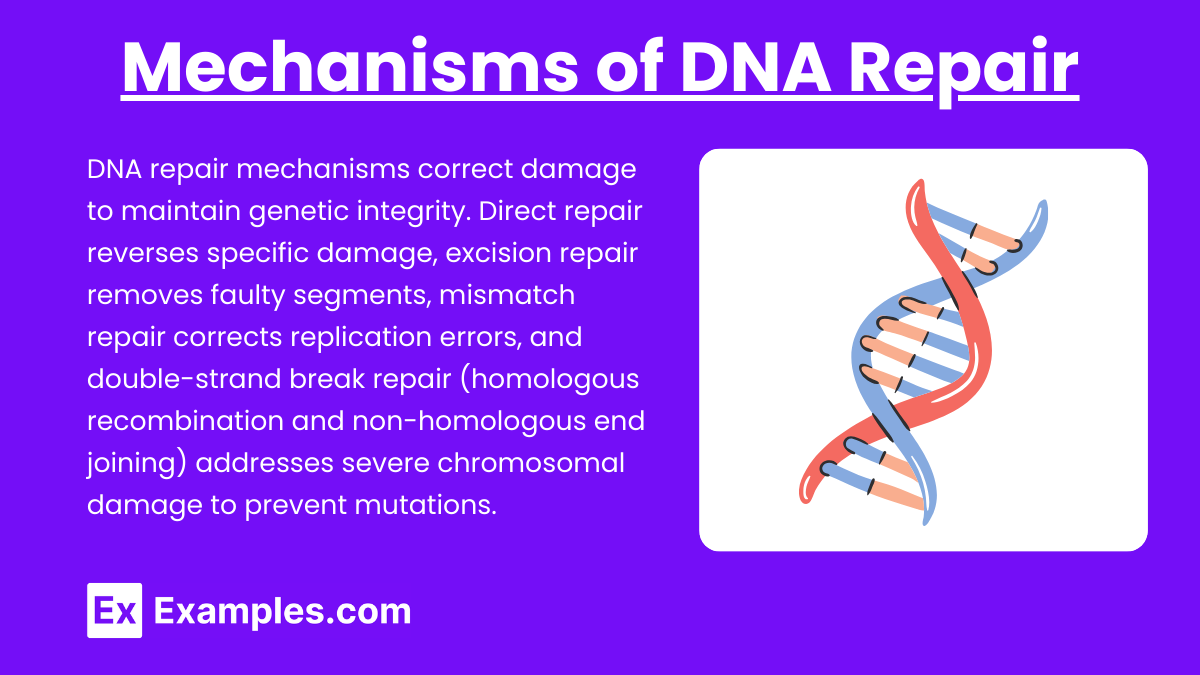
- Direct Repair: Direct reversal of specific damage, e.g., photoreactivation repairs UV-induced thymine dimers.
- Excision Repair:
- Base Excision Repair (BER): Repairs small, non-helix-distorting lesions by removing single bases.
- Nucleotide Excision Repair (NER): Corrects bulky, helix-distorting lesions by removing a short DNA segment.
- Mismatch Repair (MMR): Fixes replication errors immediately after DNA synthesis by excising and replacing mismatched bases.
- Double-Strand Break Repair:
- Homologous Recombination (HR): Uses a sister chromatid as a template to accurately repair breaks.
- Non-Homologous End Joining (NHEJ): Joins broken ends without a template, often leading to insertions or deletions.
4. Genetic Mutations in Disease
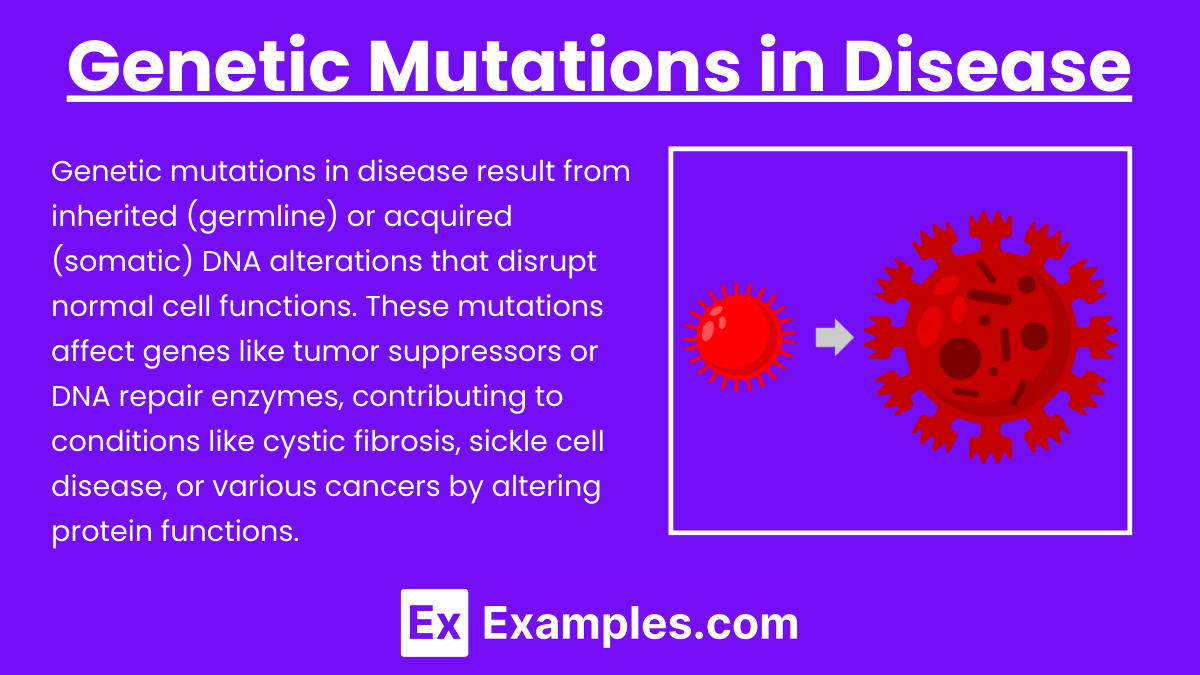
- Hereditary Mutations: Germline mutations inherited through parental DNA; affects all cells in the body.
- Somatic Mutations: Acquired mutations in non-germline cells; often associated with cancer.
- Examples of Diseases:
- Cystic Fibrosis: Caused by a deletion mutation in the CFTR gene.
- Sickle Cell Disease: Caused by a missense mutation in the hemoglobin gene.
- Cancer: Often involves mutations in proto-oncogenes, tumor suppressor genes, or DNA repair genes.
5. Mutational Impact on Evolution and Population Genetics
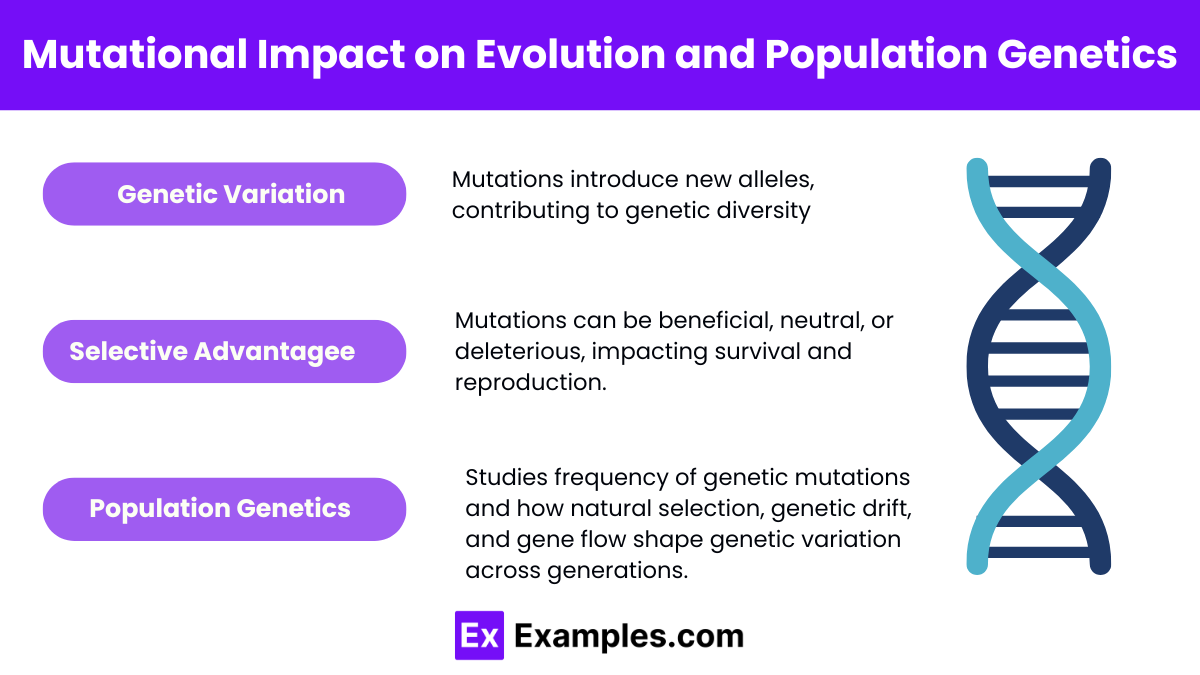
- Genetic Variation: Mutations introduce new alleles, contributing to genetic diversity.
- Selective Advantage/Disadvantage: Mutations can be beneficial, neutral, or deleterious, impacting survival and reproduction.
- Population Genetics: Studies frequency of genetic mutations and how natural selection, genetic drift, and gene flow shape genetic variation across generations.
Examples
Example 1: Point Mutations and Their Effects on Protein Synthesis
- A single nucleotide substitution occurs in a gene, leading to a point mutation.
- If this substitution results in a different amino acid being incorporated into a protein, it’s called a missense mutation. This can affect protein function, depending on the location and nature of the amino acid change.
Example 2: Frameshift Mutations and Protein Truncation
- Frameshift mutations occur when nucleotides are inserted or deleted, altering the reading frame of the gene.
- This type of mutation often results in an entirely different amino acid sequence downstream, leading to early termination or nonfunctional proteins.
Example 3: Chromosomal Deletion and Disease Association
- Large deletions in chromosomes can remove multiple genes, leading to significant functional impairments.
- For instance, deletions on chromosome 22 are associated with DiGeorge syndrome, impacting immune function, heart structure, and more.
Example 4: Duplication and Gene Dosage Effects
- Gene duplications occur when a segment of DNA is duplicated, resulting in extra copies of a gene.
- Increased gene dosage from duplications can lead to conditions like Charcot-Marie-Tooth disease, where excess protein disrupts nerve function.
Example 5: Nonsense Mutations and Premature Stop Codons
- A nonsense mutation changes an amino acid codon to a stop codon, prematurely terminating translation.
- This results in truncated proteins that are often nonfunctional and may lead to diseases like Duchenne Muscular Dystrophy.
Practice Questions
Question 1:
What type of mutation involves the insertion or deletion of nucleotides that alters the reading frame of the gene?
A) Point mutation
B) Silent mutation
C) Frameshift mutation
D) Nonsense mutation
Answer: C) Frameshift mutation
Explanation:
A frameshift mutation involves the insertion or deletion of nucleotides in numbers that are not multiples of three, which shifts the reading frame. This change affects all downstream codons, often leading to a nonfunctional protein.
Question 2:
A nonsense mutation results in:
A) The substitution of one amino acid for another
B) A premature stop codon, ending protein synthesis
C) Duplication of an entire gene
D) A shift in the reading frame of the gene
Answer: B) A premature stop codon, ending protein synthesis
Explanation:
Nonsense mutations alter a codon to become a stop codon, which halts translation prematurely. This results in a truncated protein that is often nonfunctional.
Question 3:
Which of the following genetic mutations is most likely associated with gene dosage effects?
A) Inversion
B) Deletion
C) Duplication
D) Point mutation
Answer: C) Duplication
Explanation:
Gene duplication results in additional copies of a gene, leading to an increase in gene product. This increase in gene dosage can disrupt cellular processes and is associated with various genetic disorders.
Genetic mutations are changes in the DNA sequence that can affect protein function and lead to various outcomes, from genetic diversity to disease. These mutations include point mutations, frameshifts, and larger chromosomal alterations. Understanding their types, causes, and impacts on health and evolution is essential for mastering genetics concepts on the MCAT.
Learning Objectives
In studying "Genetic Mutations" for the MCAT, you should learn to understand the types of genetic mutations, including point mutations, insertions, deletions, and frameshifts, and their effects on DNA and protein synthesis. Analyze how mutations can lead to altered gene expression and function, contributing to genetic disorders and cancer. Evaluate the mechanisms of DNA repair and the role of mutagens. Additionally, explore how genetic mutations influence evolutionary processes and apply these concepts to MCAT practice passages, interpreting data and experiments related to mutation and inheritance.
1. Definition and Types of Mutations

Mutation: A change in DNA sequence, potentially impacting gene function.
Types of Mutations:
Point Mutations: Change in a single nucleotide; includes substitutions.
Silent Mutations: No amino acid change due to codon redundancy.
Missense Mutations: Alters an amino acid in the protein.
Nonsense Mutations: Introduces a premature stop codon.
Frameshift Mutations: Insertions or deletions that disrupt the reading frame, altering downstream amino acids.
Large-Scale Mutations: Include duplications, deletions, inversions, and translocations impacting chromosomal structure.
2. Causes of Genetic Mutations

Spontaneous Mutations: Occur naturally during DNA replication errors or spontaneous chemical changes.
Induced Mutations: Caused by external factors (mutagens).
Physical Mutagens: Radiation (UV light, X-rays) causing pyrimidine dimers or breaks.
Chemical Mutagens: Base analogs, alkylating agents, and intercalating agents causing replication errors.
Biological Mutagens: Viruses that integrate into the host genome, possibly disrupting genes.
3. Mechanisms of DNA Repair

Direct Repair: Direct reversal of specific damage, e.g., photoreactivation repairs UV-induced thymine dimers.
Excision Repair:
Base Excision Repair (BER): Repairs small, non-helix-distorting lesions by removing single bases.
Nucleotide Excision Repair (NER): Corrects bulky, helix-distorting lesions by removing a short DNA segment.
Mismatch Repair (MMR): Fixes replication errors immediately after DNA synthesis by excising and replacing mismatched bases.
Double-Strand Break Repair:
Homologous Recombination (HR): Uses a sister chromatid as a template to accurately repair breaks.
Non-Homologous End Joining (NHEJ): Joins broken ends without a template, often leading to insertions or deletions.
4. Genetic Mutations in Disease

Hereditary Mutations: Germline mutations inherited through parental DNA; affects all cells in the body.
Somatic Mutations: Acquired mutations in non-germline cells; often associated with cancer.
Examples of Diseases:
Cystic Fibrosis: Caused by a deletion mutation in the CFTR gene.
Sickle Cell Disease: Caused by a missense mutation in the hemoglobin gene.
Cancer: Often involves mutations in proto-oncogenes, tumor suppressor genes, or DNA repair genes.
5. Mutational Impact on Evolution and Population Genetics

Genetic Variation: Mutations introduce new alleles, contributing to genetic diversity.
Selective Advantage/Disadvantage: Mutations can be beneficial, neutral, or deleterious, impacting survival and reproduction.
Population Genetics: Studies frequency of genetic mutations and how natural selection, genetic drift, and gene flow shape genetic variation across generations.
Examples
Example 1: Point Mutations and Their Effects on Protein Synthesis
A single nucleotide substitution occurs in a gene, leading to a point mutation.
If this substitution results in a different amino acid being incorporated into a protein, it’s called a missense mutation. This can affect protein function, depending on the location and nature of the amino acid change.
Example 2: Frameshift Mutations and Protein Truncation
Frameshift mutations occur when nucleotides are inserted or deleted, altering the reading frame of the gene.
This type of mutation often results in an entirely different amino acid sequence downstream, leading to early termination or nonfunctional proteins.
Example 3: Chromosomal Deletion and Disease Association
Large deletions in chromosomes can remove multiple genes, leading to significant functional impairments.
For instance, deletions on chromosome 22 are associated with DiGeorge syndrome, impacting immune function, heart structure, and more.
Example 4: Duplication and Gene Dosage Effects
Gene duplications occur when a segment of DNA is duplicated, resulting in extra copies of a gene.
Increased gene dosage from duplications can lead to conditions like Charcot-Marie-Tooth disease, where excess protein disrupts nerve function.
Example 5: Nonsense Mutations and Premature Stop Codons
A nonsense mutation changes an amino acid codon to a stop codon, prematurely terminating translation.
This results in truncated proteins that are often nonfunctional and may lead to diseases like Duchenne Muscular Dystrophy.
Practice Questions
Question 1:
What type of mutation involves the insertion or deletion of nucleotides that alters the reading frame of the gene?
A) Point mutation
B) Silent mutation
C) Frameshift mutation
D) Nonsense mutation
Answer: C) Frameshift mutation
Explanation:
A frameshift mutation involves the insertion or deletion of nucleotides in numbers that are not multiples of three, which shifts the reading frame. This change affects all downstream codons, often leading to a nonfunctional protein.
Question 2:
A nonsense mutation results in:
A) The substitution of one amino acid for another
B) A premature stop codon, ending protein synthesis
C) Duplication of an entire gene
D) A shift in the reading frame of the gene
Answer: B) A premature stop codon, ending protein synthesis
Explanation:
Nonsense mutations alter a codon to become a stop codon, which halts translation prematurely. This results in a truncated protein that is often nonfunctional.
Question 3:
Which of the following genetic mutations is most likely associated with gene dosage effects?
A) Inversion
B) Deletion
C) Duplication
D) Point mutation
Answer: C) Duplication
Explanation:
Gene duplication results in additional copies of a gene, leading to an increase in gene product. This increase in gene dosage can disrupt cellular processes and is associated with various genetic disorders.

